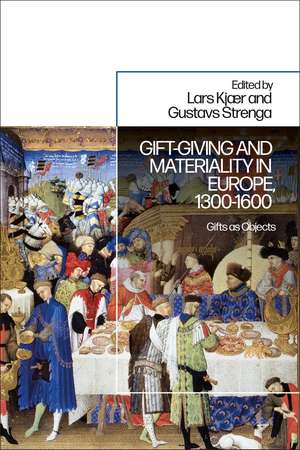Gift-Giving and Materiality in Europe, 1300-1600: Gifts as Objects
Editat de Dr Lars Kjaer, Dr Gustavs Strengaen Limba Engleză Paperback – 17 apr 2024
| Toate formatele și edițiile | Preț | Express |
|---|---|---|
| Paperback (1) | 192.30 lei 6-8 săpt. | |
| Bloomsbury Publishing – 17 apr 2024 | 192.30 lei 6-8 săpt. | |
| Hardback (1) | 540.54 lei 6-8 săpt. | |
| Bloomsbury Publishing – 5 oct 2022 | 540.54 lei 6-8 săpt. |
Preț: 192.30 lei
Preț vechi: 249.87 lei
-23% Nou
Puncte Express: 288
Preț estimativ în valută:
36.80€ • 38.02$ • 30.63£
36.80€ • 38.02$ • 30.63£
Carte tipărită la comandă
Livrare economică 25 martie-08 aprilie
Preluare comenzi: 021 569.72.76
Specificații
ISBN-13: 9781350186101
ISBN-10: 1350186104
Pagini: 272
Ilustrații: 30 bw illus
Dimensiuni: 156 x 234 x 25 mm
Greutate: 0.39 kg
Editura: Bloomsbury Publishing
Colecția Bloomsbury Academic
Locul publicării:London, United Kingdom
ISBN-10: 1350186104
Pagini: 272
Ilustrații: 30 bw illus
Dimensiuni: 156 x 234 x 25 mm
Greutate: 0.39 kg
Editura: Bloomsbury Publishing
Colecția Bloomsbury Academic
Locul publicării:London, United Kingdom
Caracteristici
Expert contributions from the UK, Switzerland, Germany, Estonia, France, Denmark, Finland and the Netherlands
Notă biografică
Lars Kjaer is Associate Professor in Medieval History at the New College of the Humanities, UK. He is the author of The Medieval Gift and the Classical Tradition (2019) and the co-editor of Denmark and Europe in the Middle Ages (2014).Gustavs Strenga is a Postdoctoral Researcher at University of Greifswald, Germany. He has previously worked as a Postdoctoral Research Fellow at Tallinn University, Estonia, and Researcher at the National Library of Latvia.
Cuprins
List of Illustrations1. Introduction: The Matter of the Gift - Lars Kjaer (New College of the Humanities, UK)2. Of Ivory, Gold and Elephants: Materiality and Agency of Pre-modern Chairs as Gifts - Sabine Sommerer (University of Zurich, Switzerland)3. Rituals, Objects and Conflicts: Gifts Given during the Entry of Archbishop Silvester Stodewescher in the Riga Cathedral (1449) - Gustavs Strenga (Tallinn University, Estonia)4. (Re)moving Relics and Performing Gift Exchange between Early Modern Tuscany and Lithuania - Ruth S. Noyes (National Museum of Denmark, Denmark)5. Gift-giving and the Cult of Living Matter in Late Medieval Europe - Mads Heilskov (EHESS, France)6. With this Rynge': The Materiality and Meaning of Late Medieval Marriage Rings - Anna Boeles Rowland(University of Leuven, Netherlands)7. Votive Offerings as Communication: Gift Exchange with Saint Nicholas of Tolentino (14th-16th Centuries) - Sari Katajala-Peltomaa (Tampere University, Finland)8. Alms Boxes and Charity: Giving to the Poor after the Lutheran Reformation in Denmark - Poul Grinder-Hansen (National Museum of Denmark, Denmark)9. Beyond Materiality: Circulating Objects and the Semantics of Violent Transactions in Late Medieval Baltic Urban Spaces - Philipp Höhn (University of Halle-Wittenberg, Germany)10. Conclusion - Miri Rubin (Queen Mary University of London, UK)Index
Recenzii
This deeply learned and theoretically nuanced collection of essays explores the importance of materiality in the study of gift and counter-gift. From rings to chairs to banners, relics, elephant bones, and one's self, the specificity of the object given was essential in creating the lasting relationships cemented in gift exchange, ensuring that the giver remained physically present with the receiver. And yet these objects had lives of their own, their significance changing over time in relationship to the communities that preserved them. The essays discuss not only the gifts themselves but objects such as poor boxes and images that were integral to gift-giving. Spanning the late Middle Ages to the early modern period, the volume also considers the changing meaning of gift giving brought about by the Reformation.
Gift-exchange, long treated as the motor of social relations in archaic societies, is brought to fresh life in these innovative and reflective essays. They return us to the emotional content of the gift and bring out the special qualities of the material objects that made gifting so attractive. The collection sweeps right across Europe in the late medieval and early modern periods. Its breadth and originality make it both fascinating and compelling.
Gift-exchange, long treated as the motor of social relations in archaic societies, is brought to fresh life in these innovative and reflective essays. They return us to the emotional content of the gift and bring out the special qualities of the material objects that made gifting so attractive. The collection sweeps right across Europe in the late medieval and early modern periods. Its breadth and originality make it both fascinating and compelling.
